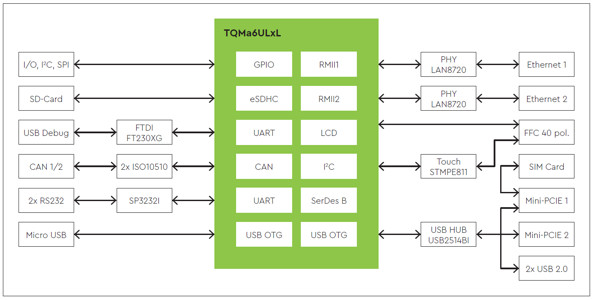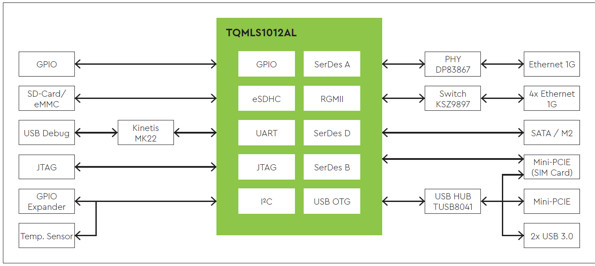Increasing Importance of Arm-Based Platforms
March 31, 2020
Story

As a market trend, it is clearly visible that more and more customers are asking for Arm-based solutions.
As a market trend, it is clearly visible that more and more customers are asking for Arm-based solutions. From embedded modules to ready-to-use solutions, such as BoxPCs, the range of systems available on the market is enormous. Devices with an Arm CPU stand out particularly due to the excellent ratio of computing power to power dissipation.
Compared to other architectures, Arm-based CPUs have the highest performance per chip area and are therefore leaders in chip technology. The Arm-based CPUs of several manufacturers are currently experiencing rapid development. In terms of performance, Arm offers not only the current 32-bit computing cores, such as Cortex-A7, but also 64-bit computing cores, such as Cortex-A53 or Cortex-A72.
Despite their much higher performance, these still have an excellent ratio between computing performance and power consumption. The Arm-based NXP families i.MX and Layerscape were developed under the premise of achieving above-average results in the field of data communication and data transfer with as little computing power as possible. The CPUs available on the market today provide all necessary interfaces for connecting mass storage devices or for fast data communication.
Due to these characteristics, the Arm architecture is the ideal basis for the implementation of Single Board Computers (SBC), platforms, and BoxPCs. The market is flooded with such solutions. Many customers often start their development with subsidized systems from Asian countries, or low-cost suppliers, due to tempting prices.
However, a closer look quickly reveals that some devices do not meet the most basic requirements in terms of long-term availability, durability or robustness. When selecting a supplier or manufacturer, special attention should be paid to ensure that these system characteristics are taken into account during the development phase, so that there are no unpleasant surprises later. In most cases, late effects only occur after years…the warranty has expired, adequate replacements cannot be delivered, and the companies suffer a loss of image with their end customers. It is therefore advisable to rely on well-established manufacturers who have many years of experience in this market segment and can thus guarantee long-term availability and durability of the product.
Modular systems are a solution approach for the constantly growing requirements. These are usually based on an embedded module and a carrier board that provides interfaces such as Mini PCIe, M.2 SATA or M.2 PCIe. SBCs and platforms can thus be easily and individually expanded with wireless or storage solutions. With a modular concept, which also provides suitable housings, complete devices can also be implemented, based on the existing mainboard solutions. This allows customers to decide whether a platform should be used with or without housing.
Manufacturers of Arm-based CPU modules often offer coherent concepts for systems and complete devices. Due to the system function provided by the CPU and a large number of interfaces, cost-effective routers, data loggers, or gateways can be developed without great effort.
The majority of industrial equipment, medical devices and control systems in operation today are not designed for future-oriented networking. Up to now, expensive BoxPCs or custom-made solutions have often been developed from scratch at high cost. Manufacturers and operators of such plants are therefore looking for gateways, routers and data loggers to retrofit their machines with Industry 4.0 at low cost and energy efficient. Companies are confronted with the task of creating a project-specific solution according to their requirements.
In the industrial age of digitalization we are literally facing many new demanding challenges. On the one hand, we are increasingly required to save energy, and on the other hand, it is expected that data and information is available anytime and anywhere. In order to implement Vision IIoT, also known as Industry 4.0, in terms of the required energy savings, intelligent system concepts are required.
Important prerequisites for this are the localization and networking of all systems, the use of energy-efficient systems, and the transmission of necessary information instead of complex and large amounts of data.
Another important point in connected machines, systems and devices, as well as the transmission of safety-critical information, is a suitable safety concept. Who wants information and data to be misused and published by hackers, security loopholes or insufficient protection?
For simple and small gateways, data loggers and protocol converters, also in combination with graphic support, the Cortex-A7 technology is very well suited. Besides a good interface support it is very energy efficient. In these CPUs numerous interfaces such as USB, 2x Ethernet, 2x CAN, UARTs, and graphics have been integrated. Thus, small and cost-effective devices for retrofitting systems can be created without much additional effort. Required wireless solutions such as WiFi, Bluetooth, LoRaWan, and mobile networks can be connected easily via USB, SDIO or SPI. A large number of sensors can be directly connected to these CPUs. The modular system concept leaves almost no requirement unsatisfied. Customers can flexibly select the required functionality according to their requirements. If desired functions are not available, they can usually be implemented cost-effectively on the basis of the modular approach.

Modular platform based on Cortex-A7 (gateway, data logger, HMI)
Especially in the field of CPU manufacturing, new standards have been set in recent years. With the LS1012A CPU it was important to reduce power consumption, save costs, and increase computing performance. This was achieved with a single 64-bit Cortex A53 core in combination with high-speed interfaces such as PCIe, Gigabit Ethernet and USB3.0. Based on this, an SBC was developed that guarantees considerable data throughput at low clock frequencies and low power dissipation. Thus, many requirements can be covered well.

Modular platform based on Layerscape LS1012A (data logger, gateway, router)
An absolute highlight is the system that was developed based on the LS1028A. This platform offers on only 6.3” x 3.9” a 4-port Gbit TSN switch, 2x Gbit Ethernet, USB 3.0, 2x PCIe, m.2 SATA, 2x CAN, and an embedded display port with GPU support.
These features allow the platform to be used in projects with real-time requirements.

Modular platform based on Layerscape LS1028A (data logger, gateway, TSN router)
For all three systems, TQ offers a housing concept with which the SBCs and platforms can also be used as passively cooled BoxPCs. In addition, modular wireless solutions such as WiFi, LoRaWan, Sigfox, and even mobile phone connections are offered.
Gateways and data loggers connected to sensors are usually required to organize large quantities of data. In order to ensure the performance of smaller CPU architectures and to keep the power loss low, the use of an SQL database is recommended. A database application provides only the required information from the large quantities of data available. This reduces the amount of data to be transferred to a minimum. Databases can also be used to cover a sufficient safety concept for the networking of machines, systems and devices and the transmission of safety-critical information.
In the course of digitalization, a rapid development can be observed. In order to make existing industrial plants and systems network-compatible, retrofittable energy-efficient and cost-effective solutions are required. Especially in the field of embedded solutions, the Arm® Architecture with its EcoSystem, which is geared towards this area, represents a reliable, robust and long-term available platform for solutions in many areas and market segments.




